
USS Paulding, name ship of a class of twenty-one 742-ton destroyers, was built at Bath, Maine. She was commissioned in late September 1910, the first of the dozen four-smokestack versions of her class (USS Roe, initial member of the nine three-smokestack variants, had entered service less than two weeks earlier). During the years prior to U.S. entry into World War I, Paulding operated with the Atlantic Fleet's torpedo force, mainly along the U.S. East Coast. In May 1917, about six weeks after the Congress declared war on Germany, she steamed to Queenstown, Ireland, to begin anti-submarine patrol and escort duty in the U-boat infested waters near the British Isles. Paulding returned home after the November 1918 Armistice and was decommissioned in August 1919.
In 1924, the struggle to enforce the Nation's laws against alcoholic beverages brought her back to active duty as USCGC Paulding (CG-17). Her Coast Guard service saw a tragic accident when, on 17 December 1927, she rammed and sank the submarine S-4 off Cape Cod. After repairs to her crushed bow, the destroyer returned to anti-rum-runner patrols. Paulding was returned to the Navy in October 1930 and laid up at the Philadelphia Navy Yard. She was stricken from the list of Navy ships in June 1934 and scrapped.
USS Paulding was named in honor of Rear Admiral Hiram Paulding (1797-1878), who commanded the New York Navy Yard during the Civil War.
This page features all the views we have concerning USS USS Paulding (Destroyer # 22, later DD-22).
| If you want higher resolution reproductions than the digital images presented here, see: "How to Obtain Photographic Reproductions." |
Click on the small photograph to prompt a larger view of the same image.
|
Photo #: 111-SC-6872 USS Paulding (Destroyer # 22) Standing by near a small boat, in the vicinity of Queenstown, Ireland, 1918. Photograph from the Army Signal Corps Collection in the U.S. National Archives. Online Image: 78KB; 740 x 575 pixels Reproductions of this image may also be available through the National Archives photographic reproduction system. |
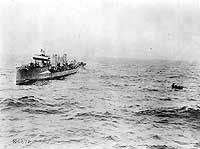 |
|
Photo #: NH 42809 USS Paulding (Destroyer # 22) Moored at Queenstown, Ireland, in 1918, while wearing pattern camouflage. U.S. Naval Historical Center Photograph. Online Image: 70KB; 740 x 445 pixels |
 |
|
Photo #: NH 42810 USS Paulding (Destroyer # 22) In drydock at Queenstown, Ireland, while receiving repairs to her bow, 1918. U.S. Naval Historical Center Photograph. Online Image: 99KB; 740 x 545 pixels |
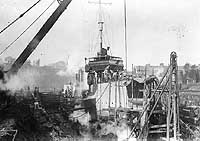 |
|
Photo #: NH 42811 USS Paulding (Destroyer # 22) Drydocked for repairs at Queenstown, Ireland, 1918. Her bow appears to have suffered collision damage. U.S. Naval Historical Center Photograph. Online Image: 97KB; 580 x 765 pixels |
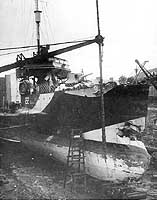 |
|
Photo #: NH 69120 USCGC Paulding (CG-17) On the Marine Railway at the Boston Navy Yard, Charlestown, Massachusetts, 26 December 1927, showing damage to her bow from her collision with USS S-4 (SS-109) on 17 December 1927. She was originally USS Paulding (DD-22). Courtesy of the San Francisco Maritime Museum, San Francisco, California, 1969. U.S. Naval Historical Center Photograph. Online Image: 110KB; 740 x 610 pixels |
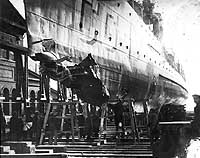 |
|
Photo #: NH 41827 USS S-4 (SS-109) Interior view of the hole in the starboard side of her Battery Room, made when she collided with USCGC Paulding off Provincetown, Massachusetts, on 17 December 1927. Photographed at the Boston Navy Yard, Charlestown, Massachusetts, 23 March 1928. A portion of Paulding's bow can be seen protruding through the hole, which is 2 1/2 feet in length and one foot in height. The hole appears to have been packed with folded fabric to reduce water inflow. U.S. Naval Historical Center Photograph. Online Image: 120KB; 740 x 600 pixels |
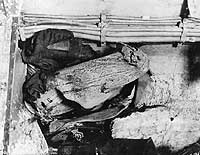 |
| If you want higher resolution reproductions than the digital images presented here, see: "How to Obtain Photographic Reproductions." |
Page made 10 April 2005
New image added 14 October 2005